Sharlyn J. Lauby's Blog, page 23
May 2, 2024
How to Write an Email that Others Will Read

Estimated reading time: 4 minutes
Recently, I received a reader note asking for some resources to help someone improve their writing skills. Specifically, they wanted to help someone write better emails. As I was thinking about a reply, it occurred to me that writing emails is one of those things that we expect everyone to know how to do but there’s really no book or training manual around.
Many years ago, I worked for a company that had an internal writing guide. It’s the only organization I’ve ever seen with one. It outlined how to communicate in writing to both internal and external audiences. So, in an effort to put together a guide for writing an effective email, I reached out to my friends and colleagues for some tips. And they shared some great responses.
I’ve condensed some of the duplicate comments and decided to organize them by start, body, and closing. Whether you’re new to writing emails or looking for a refresher, I hope you find these helpful.
Starting the email
Before you just start writing an email, think about what you’re trying to accomplish. This doesn’t need to take hours, but just take a moment to think about what you want.
Email is not a substitute for human interaction. I simply cannot stress this enough. Keep in mind that people read emails on many different devices (desktop, laptop, tablet, phone). This might have an impact on how they interpret the message and how they respond. Example: it’s very difficult to write a lengthy reply using your phone. Avoid the blast email to everyone. (And this applies equally to the “reply all” email.)Know what cc and bcc mean. The cc means carbon copy and simply is an FYI, no response is required. The bcc is blind carbon copy and ideally is used when you want to keep someone in the loop without the rest of the group knowing. That being said, there are plenty of people who do not take the time to realize they were bcc’d and give themselves away. The bcc line should be used with caution. Write a good subject line. If you are requesting an action, you might want to put it in the subject. Some people might disagree with me, but if I’m sending a time sensitive email, I put “TIME SENSITIVE” in the subject line.Body of the email
The goal of an email is to communicate information clearly and succinctly.
Use the person’s name, as in “Hi Leonard”. Some people hate the “I hope this finds you well.”. You can decide if it’s necessary. If you’re requesting an action, you might want to start with that. “The purpose of this email is …” Basically, before you start writing, understand the purpose of the email. Is it to inform? Persuade?Make the email about one thing. It helps the reader stay focused. If the email is asking the reader to do 2, 3, 4 things … you might not receive everything you’re requesting. Be succinct.Subheadings and bullets can help the reader organize information. Some people said to avoid jargon, but if everyone on the email knows the jargon, then that might be fine. Hyperlinks can be a helpful way to provide additional information. Be careful about shortening urls and not showing the full web address. In today’s world of phishing, some readers will not click on a link even if you’re a trusted source.Closing the email
Before you hit the send button, take one last look at the email.
Proofread it! For typos and tone. One of the disadvantages with email is that tone doesn’t really come across. This isn’t the time to try to write jokes or be sarcastic. People might misinterpret your intent. Consider asking AI to proofread it for you. Several people said that they have artificial intelligence (AI) review their emails and offer suggestions. If you’re wanting to learn more about AI, this might be a great experiment. If you mention an attachment, make sure it’s there (yes, we’ve all done it). Decide if you need to sleep on it before sending. Sometimes, we have to send messages via email because there’s no other option. If you draft an email when you’re tired or cranky, consider letting it sit for a few hours or overnight and then rereading it one last time before sending.I’m sure this isn’t a comprehensive list. If I missed something, be sure to add a comment. This could be a great resource for someone looking to keep their email writing skills current.
Email remains a huge communication tool in today’s work environment. Knowing how to write a good email is important. As you perfect your writing skills, your confidence and credibility will increase.
Image captured by Sharlyn Lauby while exploring the streets of San Francisco, CA
The post How to Write an Email that Others Will Read appeared first on hr bartender.
April 30, 2024
Organizations: Prepare Leaders for Transformative Change

Estimated reading time: 7 minutes
(Editor’s Note: Today’s article is brought to you by our friends at DDI , a global leadership firm that helps organizations hire, promote, and develop exceptional leaders. They were recently named to the Forbes America’s Best Employers 2024 list . Congrats to them and enjoy the read!)
I recently published an article on how to create effective organizational change through leadership development. The article focused on everyday changes we face like when team members change, or when we experience changes in our scope of work. Changes like these happen regularly and we need to be prepared to accelerate through them.
But it occurred to me as we were talking about everyday change that we also need to talk about transformative change—and how leaders can drive change effectively. That’s the focus of today’s article.
To help us understand more about transformative change, I asked Matt Paese, Ph.D., senior vice president of leadership insights for DDI to share his thoughts. Matt has advised thousands of organizations on leadership effectiveness. He is the lead author of two books: “Grow Your Own Leaders” and “Leaders Ready Now: Accelerating Growth in a Faster World”.
Matt, thanks so much for being here. Let’s start by defining transformative change. Can you provide an example of how transformative change differs from the everyday changes we manage?
[Paese] Transformative change is necessary when an organization discovers that its culture, how they work, is misaligned with its strategy, what they are trying to achieve. For example, we’ve all been reading in the news about Boeing, which has been failing to achieve its strategic objectives and has let down both investors and customers. A safe assertion is that for Boeing to regain its footing they must radically enhance the alignment between their culture and strategy. For that, transformative change will be necessary.
“… the fundamental difference between big transformation and small change is the extent to which people are required to rethink, question assumptions, and alter habits. Change requires that we swap one approach for another, and transformation tends to require lots of those swaps, which can be difficult to understand, embrace, and enact.”
Transformative change involves numerous smaller changes, all of which must be coordinated to align ‘how we work’ with ‘what we are trying to achieve’. More specifically, transformation might be aimed at, say, moving from an efficiency culture to a quality culture. That broad transformation might require many smaller changes in processes, systems, technology, structure, people, and others. Each of these, by itself, would be a change, while together they amount to a transformation.
Note that these ‘smaller’ changes may not feel small at all to the people in the middle of them. Change that is part of transformation can still be very ‘big’, requiring strong change leadership skills.
When you boil this down to the human experience of change, the fundamental difference between big transformation and small change is the extent to which people are required to rethink, question assumptions, and alter habits. Change requires that we swap one approach for another, and transformation tends to require lots of those swaps, which can be difficult to understand, embrace, and enact.
As you’ve mentioned, transformative change can be daunting. When an organization is thinking about something of this scale, where’s a good place to start the conversation? Meaning how does the organization start preparing the leadership team for large scale change?
[Paese] The simple answer is to start with a reason, and to articulate why change will lead to good outcomes. But there’s a trick to this that many leadership teams get wrong. They talk about change from the perspective of the business, using financial returns and shareholder value as the ‘why’ of change. These are naturally crucial, but transformation requires a human connection to the change, and for that, leaders must describe the ‘why’ of change through the lenses of customers and employees.
How will customers’ lives change because of our transformation? How will the experience of work transform for all our employees?Starting with those connections and being as vivid and specific as possible is essential to building engagement in the change process.
If the organization knows they need transformative change, but they don’t know if the team is ready, how can the organization assess their leadership team?

[Paese] With regard to team readiness, there are formal assessments that can help leadership teams understand both their readiness for change as well as their skills for doing so. These aren’t surveys or ‘paper and pencil’ measures of perceptions or mindsets. They are actual change exercises and simulations aimed at helping leaders rapidly build self-awareness by seeing their own habits and behavioral tendencies in action. With rapid feedback and insight, leaders can adjust both individual and team efforts to be more aligned with the changes that need to be made. These critical insights can help organizations better understand strengths and critical development needs, provide a roadmap for coaching priorities, help facilitate accelerated growth and development, and more.
In my experience, the leadership team is often at different stages of experience and expertise. How can organizations design a leadership development solution that meets the needs of all participants?
[Paese] Very few leaders feel equipped to drive transformation. Our research indicates that 63% of leaders feel these skills are among the most critical to master, but only 29% ever receive any development to help do so.
For leaders, making change happen is an individual challenge and a team challenge. Development processes must build both into the solution. Recently with a large multi-billion-dollar business unit, the president of the unit was seeking to drive a rapid, post-pandemic transformation. He started with himself, participating in a high-speed, but in-depth assessment of his own approach to change, with help from an executive coach.
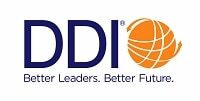
While he was isolating his own development priorities, he launched a similar process for his entire team, coupling individual self-insight experiences with team experiences. The combination allowed for leaders to pinpoint and hone their own change strategies, and for the team to align around common areas of emphasis as they sought to coordinate their efforts and speak with one voice to the rest of the organization. The results have been electric, generating extraordinary organizational enthusiasm and engagement in the change process.
Last question. For those organizations that aren’t going through transformative change right now, what’s the benefit of preparing leaders in advance for large scale change?
[Paese] In a recent keynote presentation, I asked a large audience of board members and CEOs, ‘How many of you are working on significant organizational transformations right now?’. About half the hands went up. I asked them to keep their hands up, and then asked, ‘For the rest of you, how many of you anticipate the need for transformation within the next 12-24 months?’ After that question, nearly every hand in the room was up.
In today’s context, if you’re not in the midst of a significant organizational transformation, just give it some time. Chances are you will be soon enough. Leaders who are prepared in advance are better equipped to handle the challenge smoothly and keep the team focused and motived as you accelerate through change.
I want to extend a huge thanks to Matt for sharing his expertise with us. If you’d like to learn more about preparing your leadership team for transformational change, check out DDI’s Leading Through Change challenge site. It includes articles and a sample learning journey you can review and share with your team.
As Matt mentioned, even if your organization isn’t planning a major change right now, that doesn’t mean it’s not imminent. During this year’s World Economic Forum in Davos, business leaders cited being able to respond to the speed of change as being tantamount to business success. Don’t expect that to shift anytime soon. Their second concern? Talent. Put those together and it paints a very realistic view of how competitive the business world is today and the need to give leaders the training and tools to succeed.
The post Organizations: Prepare Leaders for Transformative Change appeared first on hr bartender.
April 28, 2024
Tell Employees What It Takes to Get a Promotion
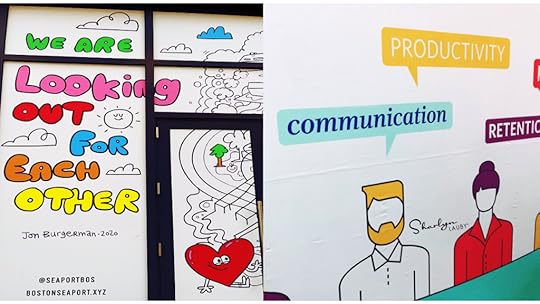
Estimated reading time: 3 minutes
Recently, Dell made news headlines by saying that remote employees can stay remote but they’re not going to be considered for promotional opportunities. I’m not here today to talk about whether this is the right decision. I’d like to think that Dell has done their homework and understands the potential consequences. But the article did remind me that organizations need to tell employees what it takes to get promoted.
Often when a new employee arrives, we’re so focused on training them for the job they were just hired for that we don’t think about when to begin conversations about the future. I’ve said before that I believe a manager’s job is to hire and train their replacement. This doesn’t happen overnight. And not every employee wants a promotion. Managers need to think about how they can talk with employees about their current performance and the future at the same time.
The reason that managers need to think about their replacement is because they will not be able to get promoted themselves if they don’t have someone to replace them in the pipeline. Oh sure, the company can promote them without a replacement identified but we all know what that means. The manager will do their new job plus their old job until the replacement is found, hired, and onboarded. So, during a time when the manager should be focused on learning their new role, they will be pulled in multiple directions. This doesn’t set someone up for success.
So, managers need to talk with employees about the future. This conversation can start during one-on-one meetings. It doesn’t have to wait for the annual performance review. Find out if the employee even wants a promotion. Some employees don’t and that’s okay. It doesn’t mean they won’t work hard and produce quality. Some employees do want a promotion and the manager needs to explain what it takes – both the technical requirements and the non-technical ones.
The technical requirements are specific to the job. An employee might need to demonstrate proficiencies in project management, decision making, communications, etc. Sometimes these proficiencies happen as part of doing the work. Or they might happen because the employee received training. Or maybe the employee was selected for a special assignment that helped them learn new skills.
The non-technical piece can be more difficult to explain, and it could be related to organizational culture. In my career, I’ve heard it described in terms of building relationships, working extra hours, volunteering for assignments … you get the point. Honestly, I’ve seen very technically qualified people turn down promotions because they weren’t on board with the non-technical requirements. That’s why it’s important to know both.
Managers should openly and honestly share what it takes to get promoted with employees and let them decide for themselves. And if employees choose not to pursue a promotion, that should be okay. Maybe an employee isn’t ready, and they will be later. Employees should not be penalized for not wanting a promotion. And organizations need to know what an employee is thinking so they can prepare for their future talent needs.
Organizations have a great talent pipeline already in their organization – their current employees. Telling employees what it takes to get promoted and then supporting their decision is about building and maintaining that pipeline. It’s time to start communicating what it takes to get a promotion in your organization.
Image captured by Sharlyn Lauby while exploring the streets of Boston, MA
The post Tell Employees What It Takes to Get a Promotion appeared first on hr bartender.
April 25, 2024
Organizational Culture: Do the Work to Get the Benefits [POLL RESULTS]
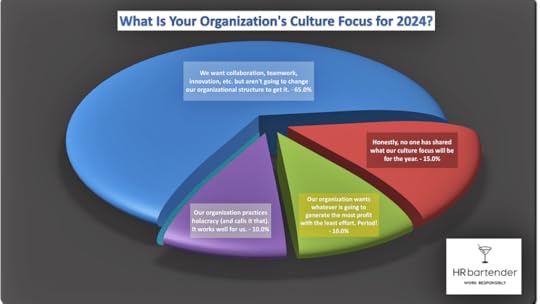
Estimated reading time: 3 minutes
A few weeks ago, I asked for your thoughts on the concept of holacracy. Just as a quick refresher, holacracy promotes flatter organizational hierarchies, distributed decision-making, and more self-management. You can see what readers said in the chart above.
First of all, I must admit that I was surprised at the low number of responses for this poll. My initial reaction was that obviously people don’t care about holacracy because there weren’t a lot of responses. But after staring at the results for a while, I couldn’t help but wonder if there’s something else going on.
With the exception of the 10% who said they practice holacracy and it works for them, the rest of the responses indicate little interest in putting in the work to have a great culture.
10% of responses were focused on profit. While many all companies are focused on the financials, the real question is how many are doing it at the expense of their employees? Holacracy aside, great company cultures take time and resources. The benefits of a great culture include employee engagement, productivity, better customer service … all things that lead to a better profit line.
15% of responses are unsure of their culture focus. Everyone in the organization should understand the company culture. Even if you’re not planning to change anything, people should know the company culture. It’s very difficult to recruit and retain employees if you can’t explain the organizational culture. I’m not just talking about HR. Hiring managers should be able to articulate the culture as well.
65% of responses said they want the benefits of holacracy without changing to a holacracy model. This is a fair response. What would be interesting to know is if the organization is prepared to change to something else in order to get the benefit? I can understand not wanting holacracy, but then what is the organization prepared to do?
You don’t have to adopt holacracy to have a great organizational culture. If holacracy works for you – great! Keep up the good work.
Make no mistake, all these responses involve doing the work – whether it’s communicating what the organizational culture is, allocating time and resources to creating / maintaining it, or making the commitment to change when necessary. If organizations want the benefits of having a great culture – and we all know they do – then you have to do the work. No shortcuts. That’s how you get the reward. And the reward benefits the company, the employees, and the profit line.
The post Organizational Culture: Do the Work to Get the Benefits [POLL RESULTS] appeared first on hr bartender.
April 23, 2024
Build Trust at Work: UKG HR and Payroll eSymposium
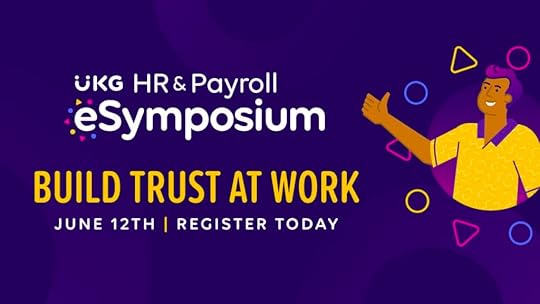
(Editor’s Note: Today’s article is brought to you by our friends at UKG , a leading provider of HR, payroll, workforce management, and culture cloud solutions. . Congrats to them and enjoy the article!)
I belong to a couple of online human resources groups. I’m sure you do too. One of the questions I’ve noticed coming up a lot lately in these groups is where human resources professionals can find free, quality professional development programs. Today’s article answers that question.
The UKG HR and Payroll eSymposium is scheduled for Wednesday, June 12, 2024, 10a to 4p Eastern. The theme for this event is “Build Trust at Work”. Organizations need to craft and maintain a culture of trust to be successful. Customers want to trust the companies they do business with. Employees want the same thing.
One way to view the value of building trust is in terms of workplace currency. I chatted about this with Julie Develin and Chas Fields in an episode of The HR Bartender Show. According to Deloitte, high trust workplaces can outperform their peers by up to 400% and achieve 2x customer satisfaction. Employees who work for a high trust employer are 79% more motivated and less likely to leave.
Making Time for Professional Development is ImportantBefore I share a few program highlights (especially the latest in Artificial Intelligence and its role in building trust), I want to remind everyone that making time for your own professional development is important.
If a manager or employee came to HR to say they don’t have time to attend a training event, we’d tell them that “developing our knowledge and skills makes us better at our jobs”. And it’s true. Now is the time to take our own advice. Here are four benefits to attending this event.
It’s FREE. Organizations are still watching their budgets. And that’s okay because there are good, free events for HR and payroll professionals. The UKG HR and Payroll eSymposium is one of those great, free events. Since the event is free, your organization can have multiple people attend, and then maybe set up a meeting to discuss takeaways from the sessions. It’s a great way for HR and payroll to learn from each other.
The content is high-quality and relevant. Our time is valuable. Even when it comes to a free event, it’s important to have good sessions with relevant takeaways. One of the things that I continue to be impressed with is the quality of speakers and cutting-edge topics that UKG brings together for these eSymposiums.
The sessions will be recorded. While this is a virtual event and being able to attend the live sessions is always beneficial, if you’re not able to, no worries. Most sessions will be made available on-demand. That way if you’re torn between two sessions you can always listen to one live and the other on-demand. Honestly, I will admit I sometimes rewatch sessions again to catch some tidbits I may have missed, especially if I’m trying to use the information in a business case presentation.
You can earn professional development credits. The educational sessions have been pre-approved for up to 14 recertification credits with several HR and payroll professional organizations (listed below). UKG will be providing a certificate of participation for your files.
Society for Human Resource Management (SHRM)Human Resources Certification Institute (HRCI)PayrollOrg (formerly American Payroll Association)Human Resources Professionals Association (HRPA)Chartered Professionals in Human Resources Saskatchewan (CPHR-SK)National Payroll Institute (NPI)This HR and Payroll eSymposium has several sessions designed to help individuals and organizations examine their current workplace strategies and design some new ones. You can check out the full agenda, speaker profiles, and register by visiting the HR and Payroll eSymposium website, but here are a few sessions that immediately caught my attention.
Cultivating Connection: Building Trust in the Workplace of the Future
Cultivating a culture of connection has never been more crucial, and yet the research consistently shows that there is an epidemic of loneliness, disconnection, and declining trust between colleagues. Morag Barrett and Ruby Vesely from SkyeTeam will share the challenges and friction points that emerge in a hybrid world and the hidden cost that a lack of trust levies on team dynamics, productivity, and overall organizational health. With real-world examples, you’ll identify the first steps you can take to cultivate a culture of connection in a world of disconnection, ensuring that trust becomes the bedrock of every interaction.
InspirAItion at Work: Real Talk on How AI Makes Great Workplaces Even Better
GenAI and other emerging AI technologies have created a major buzz at most organizations, but what does any of it actually look like in practice? How do we use these powerful tools in the right ways to make the biggest impact? In this panel discussion, they bring together analyst, technologist, and practitioner perspectives to provide real, on-the-ground examples of what’s possible, proving that AI is most valuable when used in service of people. You’ll leave this session with actionable insights into creating the kinds of empowering employee experiences that drive tangible business success through ethical, culture-focused AI solutions.
Building Trust Through Enhanced Security Measures
In today’s digital landscape, ensuring robust security measures within organizations is paramount to fostering trust, safeguarding data, and promoting information sharing. To achieve this, organizations must adopt comprehensive strategies addressing various security aspects. During this session, Mustapha Kebbeh, chief security officer at UKG, will discuss how organizations can build effective, resilient security frameworks that protect sensitive data, inspire trust among stakeholders, facilitate information sharing, and mitigate the risk of security breaches.
Turn HR Obstacles into Opportunities
Creating a great workplace can seem like a daunting task. Poor timing, budget constraints, competing priorities — these can all make the process overwhelming. But not pursuing greatness is a serious risk to the organization. As the business landscape continues to evolve, it is imperative to empower HR pros to not only navigate challenges but also to emerge as drivers of positive change and growth. Drawing insights from recent research by Great Place To Work®, Julian Lute, senior manager and strategic advisor at Great Place To Work will explore some of the most common challenges facing HR leaders along with strategies to create alignment and move forward with confidence.
 Build Trust at Work: Register for the HR and Payroll eSymposium
Build Trust at Work: Register for the HR and Payroll eSymposium I hope you’ll agree that the agenda for this HR and Payroll eSymposium looks fascinating and relevant to what’s taking place right now in the workplace. The agenda is designed to deliver education on the topics we face every day and could potentially face in the future. It has the ingredients many of us look for in professional development opportunities: 1) high-quality content, 2) no cost to attend, and 3) pre-approved for recertification. We all know this doesn’t happen very often.
HR and payroll professionals are focused on a lot of things right now, like recruiting, retention, and compliance. There are days when we say to ourselves that we can’t possibly think about carving out time to attend a professional development program. But it’s important that we find ways to build in our own professional development. We will be better HR and payroll professionals and the business will be better for it.
Sign up for the UKG HR and Payroll eSymposium. I’ve been participating in these events for several years and consistently find them to be a high-quality learning opportunity. Here are the registration details:
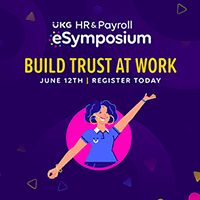
The post Build Trust at Work: UKG HR and Payroll eSymposium appeared first on hr bartender.
April 21, 2024
5 Reasons You Can’t Achieve Your Goals (and What to Do About It)
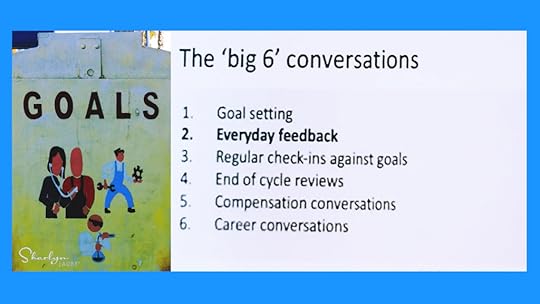
Estimated reading time: 4 minutes
Last year, I wrote an article about how “Quitting is Not a Sign of Failure”. I hope you’ll check it out when you have a moment. It’s okay to quit and it’s okay to fail at something. Today I want to talk about something related to quitting and failure. It’s when we set a goal and don’t accomplish it.
This applies to both individuals and organizations. Companies set goals all the time – revenue goals, quality goals, etc. Sometimes they meet those goals and sometimes they don’t. Same for us as individuals. We set goals to get a certification or maybe write in our journal every day. And sometimes we do it and sometimes we don’t.
If you have a goal that you’re working on … and struggling to achieve, here are a few reasons that it might be happening.
We’re trying to do too much (aka too many goals). Both organizations and individuals do this. Spreading yourself too thin has an impact on what you’re able to accomplish. Sometimes it’s very refreshing not to have a goal that you’re working on. It allows you to recharge and get ready for the next goal. Think about whether it makes sense to take a celebratory break before starting a new goal, especially if the next goal will be big and expensive to achieve. We have too many goals at the same time. This is a continuation of #1 (above). I honestly believe that part of the reason that people are unable to keep New Year’s resolutions is because they decide to start a lot of goals all at the same time. It’s okay to prioritize goals. In fact, it might actually make sense to stagger them to achieve a better outcome. There was no plan on how to achieve the goal. Goal setting is important. But once the goal is set, a plan needs to be created to achieve the goal, including the amount of resources necessary. This way, if the amount of resources needs to be changed, then you can decide to put this goal on hold for a while. Possibly focus on something else until you can replenish resources. We’re afraid to quit because we don’t want to feel like a quitter. The internet is full of lovely platitudes that say don’t quit, stay the course, try again, etc. etc. The truth is that sometimes we should quit. Maybe we’re not interested in achieving that goal anymore. Or while we would love to accomplish that goal, we’d rather spend our resources on something else. That’s just fine. Do it and move on.It’s the wrong goal. Sometimes we create goals for ourselves because everyone else is doing it. For example, I keep reading articles about pickleball. People love playing pickleball as a form of exercise. That’s terrific. If you’re a pickleball person, great! I’m not a pickleball person. I play Pokemon Go for outdoor activity and I love it. If the goal is outdoor activity, then it doesn’t matter if it’s pickleball or Pokemon. Both are good. But if the goal is pickleball, then I might not be happy. Because it’s not the right goal for me.As I mentioned earlier, goal setting is important. We should set goals. But we don’t need to set goals just to have some. We don’t need to have lots of goals at the same time. When we set a goal, we should put a plan in place to achieve it. If our situation changes, we should consider whether we need to change the goal. Being flexible with our goals will help us achieve them.
This goes for companies too. Some of the biggest mistakes I’ve seen companies make are when goals are set and never monitored to see if they need adjustments. The organization is wasting resources and senior leadership is afraid to admit they made a mistake. Make a goal, make a plan, monitor the plan, and adjust as necessary.
Image captured by Sharlyn Lauby while exploring the streets of Tampa, FL
The post 5 Reasons You Can’t Achieve Your Goals (and What to Do About It) appeared first on hr bartender.
April 18, 2024
For Productivity, Managing Employee Time is Essential
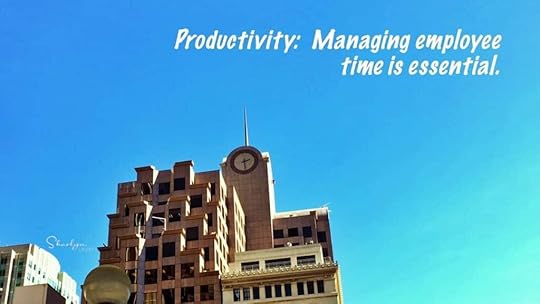
Estimated reading time: 3 minutes
Years ago, I worked for a company that was obsessed with productivity. Every month, the corporate offices would produce a report listing each location and their productivity scores. The person who produced this report – let’s call him Mr. Lumbergh – would put a line in the report. Eventually, it became known as the “Lumbergh Line”. The locations above the line were considered to have good productivity and the locations below, well, weren’t.
Today’s reader note touches on an important aspect of productivity – managing time.
Is it appropriate for a supervisor to know how much vacation, sick time, personal, and comp time an employee has?
Since this reader note doesn’t ask about legalities, we’re not going there. Alison Green over at Ask A Manager answers a similar question about tracking time off. If you have a moment, check it out. And if you have detailed questions about how much managers and supervisors are legally allowed to know when it comes to time off requests, please contact your friendly labor and employment attorney.
What I want to talk about is the importance of having a reliable process in place for managing time. At most of the places that I’ve worked, managers knew employee time off balances. The reason was simple – managers were responsible for running their operation, so they were responsible for making schedules. If an employee called in sick, they would call in to the manager who would be responsible for making sure the operation was covered.
The only time I’ve seen something different was when I worked at the airline. We had scheduling departments. The people who worked in the department were responsible for knowing the transportation laws and how many hours flight crews were able to work. They also needed to know the scheduling provisions in collective bargaining agreements. If a pilot called out sick, the scheduling department was able to look at all the pilots and figure out who could work within the established guidelines.
The reason I’m mentioning these two scenarios is because ultimately, the organization needs to have a reliable way to manage time. Both options I mentioned above worked and worked well. Organizations need to look at their operation and figure out the best system for them.
Whatever system the organization designs to track employee time has to be reliable. And it should meet the organization’s productivity needs. If a supervisor is going to be responsible for employee schedules, they need to do it well. New supervisors should receive training on how to create employee schedules and some tips for how to adjust coverage when an employee calls out unexpectedly.
If an employee calls out or would like to schedule a vacation day, there should be a process in place for them to do that. The supervisor should be able to account for time off in their schedules. And there should be a process in place for HR/payroll to be notified so the employee is properly paid from their account balances (assuming they have paid time off available).
Organizations need to operate. We all get that. Meanwhile, employees who work at the company should be able to take their earned time off. Or if an employee has no paid time off left and is faced with an emergency, they need to take care of their emergency. There needs to be a system in place that allows both productivity and time off to happen.
The post For Productivity, Managing Employee Time is Essential appeared first on hr bartender.
April 16, 2024
Organizations: Know Immediately Whenever HR and Employment Laws Change

Estimated reading time: 4 minutes
(Editor’s Note: Today’s article is brought to you by our friends at HRdirect , a trusted source for employee-related compliance, administration, and motivation tools. They serve as a one-stop shop to make employee management easier. Enjoy the read!)
I recently published an article about the importance of having a labor law posting strategy. In it, Lillian Chavez, Esq., managing legal research attorney at ComplyRight mentioned that there are on average more than 200 mandatory federal, state, city, and/or county posting changes each year. And with each change, an immediate poster update or replacement is necessary.
It got me thinking. I’m sure there are some organizations that might be saying, “Wouldn’t it be great if we had a way to know about labor law changes sooner?”. Because the faster organizations become aware of changes in legislation, the faster they can put a compliance plan in place. While I mentioned labor law posting changes at the beginning of this article, some changes to employment laws might require updates to job applications, policies and procedures, or employee handbooks. It’s also possible that the change might require employee handouts.
Being able to take a more proactive approach to compliance can also reduce any liability (i.e., fines and penalties) for non-compliance. And it shows everyone that the organization places an emphasis on following the law.
Our friends at HRdirect have an Employment Law Alert Service that can help organizations stay current with employment related legislation. This is an annual subscription service that will keep your organization informed of changes to employment laws on a federal, state, county, and city level. Here’s how it works:
HRdirect’s expert legal team will monitor employment-related legislative activity around the U.S. including over 20,000 agencies. The types of employment-related legislation that will be monitored include:
Discrimination and harassment;FMLA, sick pay, bereavement, meal breaks, and rest periods;Minimum wage, equal pay, and salary history;OSHA, safety, and smoking in the workplace;Plus, many others.When there’s a change, you’ll receive an attorney reviewed and approved email alert. The email will take you to a summary of the law – in plain language – and provide a link to the full text of the legislation for reference. It will also suggest some action items for implementing the new requirements.
This alert service positions the organization to quickly understand the change and immediately make compliance decisions. In addition to the email alerts, subscribers will have access to a database of recent alerts with suggested next steps.

HRdirect is offering a two-month FREE trial, and you don’t have to put a credit card on file to sign up. After the free trial, you will receive a $30 discount on an annual subscription. Honestly, this is a great offer. Organizations have nothing to lose by testing it out – because it’s free and you don’t have to put a credit card on file. There are three things I really like about this service.
As a human resources professional, I can feel comfortable that legal professionals are watching out for legislation that impacts my organization. That frees up my time so I can focus on doing other things like recruiting and training. When there’s a new law or a change to employment laws, I receive a summary and some talking points that I can share with my team and senior management. We can strategize on the right next step for our organization and workforce. I can use the database to conduct a mini-audit and make sure my company remains in compliance. This is a great project to conduct regularly and ensure that we’re doing all the right things.We all know that compliance is an important part of our role in human resources, but it doesn’t have to be the only thing we do. Finding partners who can help us maintain compliance just makes good business sense.
I hope you’ll check out the Employment Law Alert Service that HRdirect is offering and take advantage of the free trial. It’s a great opportunity to stay compliant, make your work easier, and provide greater value to the organization.
The post Organizations: Know Immediately Whenever HR and Employment Laws Change appeared first on hr bartender.
April 14, 2024
Add Super Advisors To Your Project Teams

Estimated reading time: 3 minutes
I’ve mentioned a couple of times that I switched planners this year and I’m using a Hobonichi Techo. This year, Hobonichi celebrated a big milestone of selling more than 10 million copies (all-time sales). To celebrate this achievement, they are creating original stationery and have been documenting the process.
The reason I’m bringing this up is because in a recent update, they talked about the group working on the stationery project talking to their “super advisors” for input. The concept of a super advisory is intriguing.
If we think of common accountability matrices – like RACI and MOCHA – where would a super advisor fit in? As a quick reminder, RACI stands for Responsible, Accountable, Consult, and Inform. Responsible are the people doing the work. Accountable is the project manager. Consult refers to the subject matter experts. And inform is the project sponsor.
In the RACI model, super advisors might have a combined consult and inform role. Maybe they are subject matter experts who can help convince / influence the project sponsor? This could be very helpful if the responsible team wants to pitch a solution that is unconventional. Also, super advisors might be able to share some of the project sponsor’s concerns in an informal fashion, without the responsible team losing enthusiasm for the project.
Another matrix I’ve mentioned in the past is MOCHA, which stands for manager, owner, consultant, helper, and approver. Manager is the person responsible for the work. Owner is the person responsible for the results. Consultant advises the group. Helper(s) are people who assist but might not be an official member of the project team. And approver is the person who approves the resources for the project.
In the MOCHA model, a super advisor might be the consultant and/or helper. They could be a subject matter expert and not officially part of the project team … but the team values their input.
Whether you’re using RACI, MOCHA, or some other model, super advisors could play a key role in helping projects run smoothly and accomplish team goals. To optimize super advisor effectiveness, here are a few things to consider.
Define the role. Super advisors can be effective if they understand their role in the project’s success. It’s equally important for project team members to know that super advisors exist and how they can contribute.
Consider training. I see super advisors as being subject matter experts and internal influencers. If someone has the communication skills but needs more technical training, it might make sense to encourage that. Conversely, if someone has the technical expertise but needs communications skills training, this might make a lot of sense.
Talk to potential super advisors about their role. Think of this as part of a career progression. Organizations often ask employees to work on a project or lead a group prior to getting a promotion. Being a super advisor could be a special project that allows someone to gain skills and build relationships.
Organizations form project teams all the time. One of the first steps in bringing a project team together is defining roles within the team. A super advisor could be a great option when you’d like someone to participate but they’re not able to be a part of the core team. Think through what a super advisor could do for your projects and consider adding the role.
Image captured by Sharlyn Lauby while exploring the streets of Las Vegas, NV
The post Add Super Advisors To Your Project Teams appeared first on hr bartender.
April 11, 2024
Bookmark This! The Teams Edition
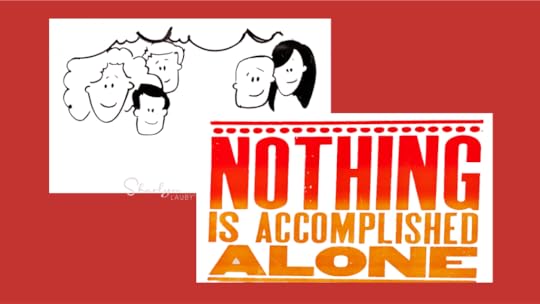
Estimated reading time: 3 minutes
The New York Times recently published an article about “Who Still Works From Home?”. While the majority of workers are back onsite, there are still a small percentage of people who work a hybrid schedule or fully remote. The article is an interesting look at what types of jobs are more likely to fall into the category of remote and hybrid work.
Regardless of where a person works, one thing is important to all workers … and that’s teamwork. Being able to participate in a team matters, even when you’re an individual contributor. And, being an effective team member is essential to individual and organizational success.
If you’re looking for some resources to help build and maintain better teams, here are three articles to get the conversation started within your organization.
3 Proven Ways to Make New Team Members Feel Welcome and Included
There are countless studies showing that structured onboarding programs not only welcome new hires into the organization, but they help with employee engagement and retention.
It’s time to take what we know about onboarding one step further and provide internal team members the same type of structured process that we provide external candidates. It doesn’t necessarily have to include an in-person classroom program, although that could be fantastic. But it does need to include a plan, communication, training, and manager involvement.
For Productivity, Engage Team Members with Emotional Intelligence
When it comes to creating employee engagement, leaders play an important role. But we need to remember that team members also share in that responsibility. Employees will be enthusiastic and dedicated to their work when they are trusted and treated with respect.
If organizations want to get things done – and we all know they do – then they need to set teams up for success. That involves giving team members, and especially your leaders, the tools they need to engage, which starts with emotional intelligence. Emotional intelligence drives team engagement and teamwork. Engaged teams get stuff done, which allows the organization to accomplish their goals.
Create Effective Organizational Change Through Leadership Development
Change happens all the time. And change can be hard. Even when the change is welcome, it still can be hard. It is critical for organizations to prepare their leaders, employees, and teams to effectively handle change.
The key to successfully managing any type of change starts with leaders. Organizations should give leaders the training and tools they need to manage change at every level. And that happens during leadership development. In turn, proper development will allow the leader to provide support to employees.
The conversation about teamwork needs to happen before new employees are hired and throughout the employee life cycle. Managers should be trained on how to build and sustain a positive team environment. Because organizations rely on teams to accomplish their goals.
Image captured by Sharlyn Lauby while exploring the streets of Nashville, TN
The post Bookmark This! The Teams Edition appeared first on hr bartender.
Sharlyn J. Lauby's Blog
- Sharlyn J. Lauby's profile
- 10 followers



